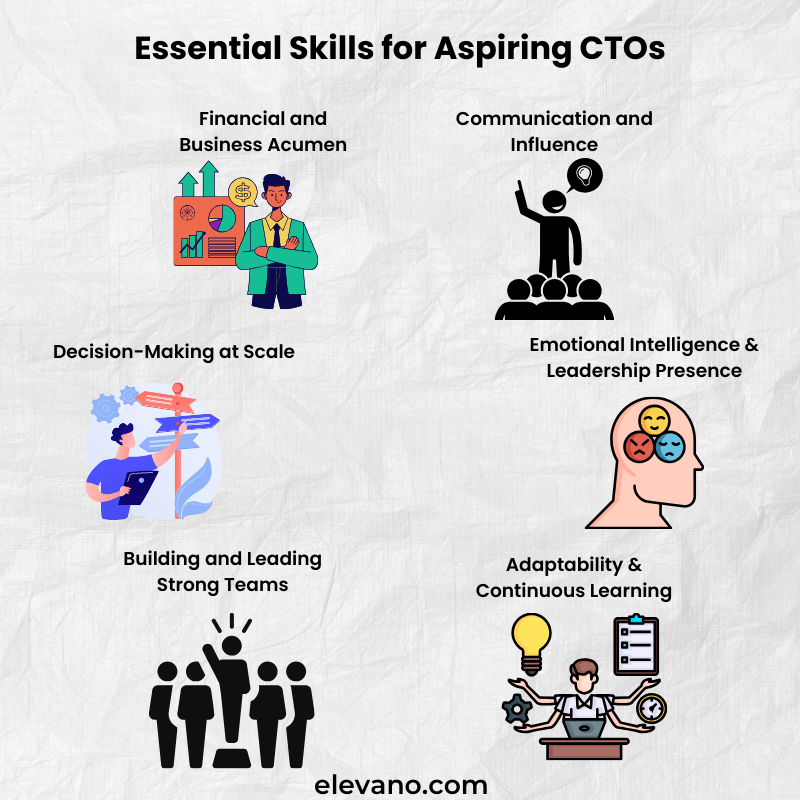For many engineers, the CTO role seems like the ultimate goal—a title that signals authority, vision, and leadership. But is it really the right path for everyone?
Becoming a CTO isn’t just about technical expertise. It’s a shift from building software to driving business strategy. The role blends technology, leadership, and financial decision-making, requiring skills beyond coding—like managing teams, aligning engineering with business goals, and influencing executive decisions. While it offers exciting opportunities, it also comes with new challenges and pressures.
On a recent podcast, Dana Lawson, CTO at Netlify, shared her journey from VP to CTO, the realities of leadership, and what engineers should know before making the leap. Having worked across multiple organizations, she’s seen firsthand how the CTO role transforms from a tech expert into a business leader.
So read on as we break down Dana’s insights—what changes at the top, the key skills you need, and how to decide if the CTO path is truly right for you.
The CTO Role: Is It the Ultimate Goal for Every Engineer?
Many engineers see the CTO title as the peak of success—the ultimate validation of their skills and leadership. But is that really the best path for everyone?
Society and corporate structures push for constant upward movement, making it seem like climbing the ladder is the only way forward. Yet, not every engineer thrives in executive leadership. Moving into a CTO role shifts the focus from technical work to business strategy, financial planning, and executive decision-making—a transition that isn’t for everyone.
As Dana Lawson pointed out, success isn’t defined by titles but by impact. Some of the most influential engineers never move into executive roles. A Director of Engineering, Principal Engineer, or Chief Architect can drive massive technical and business change without stepping away from what they love—engineering.
Why Some Engineers Prefer to Stay in Technical Leadership
Not every engineer wants or needs to become a CTO. Some find more fulfillment in hands-on technical work, solving deep engineering challenges, and leading through expertise rather than management.
Here are three alternative high-impact roles that allow engineers to grow without shifting entirely into business leadership:
Principal Engineer – Focuses on deep technical leadership without managing teams. They guide architecture, influence best practices, and mentor engineers across the company.
Chief Architect – Owns the technical vision at a company-wide level, making long-term decisions about scalability, system design, and innovation.
Director of Engineering – Balances technology and strategy but stays closer to engineering execution than a VP or CTO. They manage teams but don’t carry full business ownership.
Each of these roles offers high impact, leadership, and career growth—without requiring a move into full executive responsibilities. So before chasing a title, ask yourself: Do I want to lead people, or do I want to lead technology? The answer to that question can shape a more fulfilling career path.
The Transition from VP to CTO: What Really Changes?
From Execution to Strategy
As a VP of Engineering, your focus is on team leadership, project execution, and ensuring engineering teams deliver results efficiently. You’re deeply involved in product development, hiring, and optimizing workflows. However, stepping into the CTO role shifts the focus entirely. You move away from day-to-day technical execution and focus on long-term vision, business strategy, and financial oversight. Your responsibility isn’t just leading engineering—it’s shaping the company’s future through technology.
Dana Lawson describes this as a shift from building products to building businesses. Instead of measuring success by shipped features, CTOs measure success by business growth, technical innovation, and company-wide impact.
The Shift in Responsibilities
CTOs spend significantly less time in code reviews and sprint planning. Instead, their day-to-day involves:
Business alignment – Ensuring engineering efforts align with company goals and customer needs.
Financial planning – Budgeting for R&D, cloud infrastructure, and hiring while balancing costs and scalability.
Stakeholder communication – Reporting to the board, investors, and C-suite peers, translating technical decisions into business impact.
Cross-functional leadership – Partnering with finance, marketing, and sales to position technology as a business driver.
Big-picture decision-making – Weighing innovation against business realities, market conditions, and long-term sustainability.
While a VP executes the vision, a CTO defines it. This requires a new level of decision-making and leadership, which doesn’t come naturally to every engineer.
Learning the Business Side of Technology
One of the biggest shifts for new CTOs is moving from technical decision-making to business leadership. It’s no longer just about choosing the best architecture—it’s about making decisions that drive growth, revenue, and company success.
Dana’s advice for engineers moving up the ranks:
Understand financial metrics – Learn about profit margins, cost of goods sold (COGS), and return on investment (ROI) to make informed budget decisions.
Work with sales and marketing – Technology isn’t just about building great products; it’s about positioning them effectively in the market.
Improve executive communication – CTOs must translate technical challenges into business priorities, making sure investors, CEOs, and non-technical leaders understand the impact of engineering decisions.
Dana emphasized that CTOs must understand how their technology directly supports revenue growth. This means working closely with sales and marketing teams to position engineering efforts in a way that aligns with customer needs and market trends. A great CTO doesn’t just build great products—they ensure those products are commercially successful.
Becoming a CTO isn’t just a promotion—it’s a complete career transformation. So before taking the leap, ask yourself: Do I want to lead engineering teams, or do I want to lead a business through technology? Your answer can shape a smarter, more fulfilling career path.
Key Skills Every Aspiring CTO Needs to Develop

1. Financial and Business Acumen
A CTO’s job isn’t just about technology—it’s about making financially smart decisions that align with business goals. Instead of writing code, you’ll spend more time reviewing budgets, understanding revenue streams, and optimizing costs.
Why it matters: Every engineering decision affects profitability, scalability, and long-term sustainability.
What to learn: Business forecasts, revenue models, cloud costs, and ROI calculations.
Dana’s insight: She works closely with finance teams to ensure engineering efforts contribute to growth, not just innovation.
Understanding business metrics is just the beginning. Making decisions at scale requires balancing technical execution with long-term strategy.
2. Decision-Making at Scale
As a CTO, small technical choices can ripple across the entire company. You must balance speed vs. stability, innovation vs. risk, and technical debt vs. future flexibility.
The challenge: Every decision affects thousands—or even millions—of users.
Key shift: Moving from hands-on problem-solving to high-level strategic oversight.
How to succeed: Delegate wisely, trust your leadership team, and prioritize decisions based on long-term impact.
But leading effectively isn’t just about making the right choices—it’s about empowering others to make them too.
3. Building and Leading Strong Teams
A CTO doesn’t just manage engineers—they shape an entire engineering culture. The role shifts from solving technical problems to empowering leaders, fostering innovation, and scaling teams effectively.
From coder to coach: Your success is measured by how well your team performs, not by how much you build.
Trust and delegation: Micromanagement kills innovation—hire great leaders and let them lead.
Scaling vision: Keep teams aligned with company values while adapting to growth and change.
Leadership isn’t just about managing teams—it’s about inspiring and influencing people across the organization.
4. Communication and Influence
CTOs must bridge the gap between technical and non-technical stakeholders. Whether talking to engineers or the board, you need to translate complex ideas into clear, compelling narratives.
With CEOs & boards: Explain the business impact of tech decisions in plain language.
With engineers: Set a technical vision without micromanaging execution.
With investors & partners: Position technology as a competitive advantage in the market.
Beyond clear communication, the most effective CTOs master emotional intelligence—understanding people as well as technology.
5. Emotional Intelligence & Leadership Presence
A CTO’s influence isn’t just about what they decide—it’s about how they lead. Emotional intelligence (EQ) is crucial for building trust, handling difficult conversations, and fostering a culture of innovation.
Why it matters: Great leadership isn’t about control—it’s about connection. The ability to navigate challenges with empathy and resilience is what sets exceptional CTOs apart.
Key qualities: Self-awareness, active listening, adaptability, and knowing when to step in or step back.
Dana’s insight: The best CTOs recognize when to challenge decisions when to listen, and when to empower their teams without overstepping.
A strong presence and emotional intelligence enable CTOs to lead teams confidently—but the ability to adapt is what keeps them at the top.
6. Adaptability & Continuous Learning
Technology evolves fast, and so do business needs. A great CTO must stay ahead, challenge assumptions, and keep learning.
Why it’s essential: What worked last year might be obsolete today.
How to improve: Stay curious—seek mentorship, track industry trends, and learn from real-world experience.
Dana’s advice: The best CTOs never stop asking questions, experimenting, and evolving.
The Challenges of Being a CTO: It’s Lonely at the Top
Fewer Peers, More Isolation – The higher you climb, the fewer people truly understand your challenges. Unlike engineers who have a team, CTOs have limited peers within their company, making it harder to find direct support.
Finding the Right Mentors – Dana emphasizes the importance of building a strong external network. She leans on former bosses, investors, and other executives who’ve been in her shoes. Seeking advice from experienced leaders helps navigate difficult decisions.
Balancing Pressure & Responsibility – Every major technical and business decision rests on the CTO’s shoulders. The pressure to drive innovation while managing costs, risks, and expectations is constant. Knowing when to step in and when to trust your team is key.
Overcoming Imposter Syndrome – Even at the top, doubt creeps in. Dana advises CTOs to embrace learning, ask for help, and remember that no one has all the answers. Being vulnerable and open about challenges fosters better leadership.
Joining Executive Communities – CTOs don’t have built-in mentorship within their companies, so peer groups and leadership forums become essential. Engaging with other tech leaders offers fresh insights, real-world solutions, and a sense of belonging.
The Reality of Engineering Career Growth: What Matters Most?
Career growth in engineering isn’t just about climbing the ladder—it’s about increasing your impact. Many engineers believe the ultimate goal is to become a CTO or VP, but titles alone don’t define success. What truly matters is developing skills that make you valuable at every level.

Impact Over Titles – Career growth doesn’t always mean moving up. A Principal Engineer or Chief Architect can have just as much influence as a VP. The key is finding a role that aligns with your strengths and interests.
Mastery Creates Opportunity – The best engineers don’t chase promotions—they focus on building expertise, solving big problems, and driving change. When you create value, career progression happens naturally.
Leadership is More Than Management – Moving up doesn’t always mean leading people. Some engineers thrive in technical leadership roles, setting direction, mentoring others, and shaping company-wide strategy without managing teams.
The Business Side Matters – As you grow, technical skills alone won’t be enough. Understanding how engineering decisions impact business goals—from revenue models to customer needs—gives you a competitive edge.
Adaptability is Key – Career paths aren’t linear. The ability to pivot, learn, and take on new challenges keeps you relevant—whether that means transitioning from engineering to product, strategy, or leadership.
Dana pointed out that five years ago, rapid promotions were common—engineers moved from Senior to Director within a few years. But today, career growth is more deliberate. Engineers now have more time to build leadership skills before stepping into executive roles, making strategic career decisions even more important.
So read on, because career growth isn’t about checking off titles—it’s about building influence, staying curious, and making a real impact.
Conclusion: Is CTO the Right Role for You?
Becoming a CTO isn’t just a career move—it’s a complete shift in how you think, lead, and make decisions. But the reality is, success in engineering isn’t defined by job titles—it’s defined by the impact you create.
Some engineers find fulfillment in building and optimizing systems, others in leading teams, and some in driving business strategy. The key isn’t about chasing the highest position, but choosing a path that challenges you, aligns with your strengths, and keeps you growing.
If the CTO role excites you, start preparing now. Develop business acumen, sharpen your leadership skills, and learn to think beyond engineering. If you’re more drawn to deep technical work, embrace roles that let you innovate at scale. Whichever path you take, make sure it’s one that keeps you engaged, learning, and making a real impact.
So now here comes the good part—where do you go from here? The best careers aren’t built on promotions; they’re built on purpose. Define what success looks like for you, and go after it with clarity and confidence.




